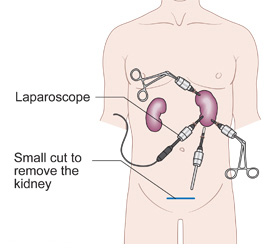
Kidney disorder is diseased state of any or both kidneys. Kidney disease usually causes kidney failure depending upon the type of disease. It can occur due to any of the following:
-
Deposition of the IgA antibodies in the glomerulus
-
Overuse of analgesics
-
Toxicity of chemotherapy agents
-
Excessive exposure to lead or its salts
-
Certain chronic conditions like systemic lupus erythematosus, diabetes mellitus and hypertension etc.
-
Polycystic disease of the kidneys
Diagnosis of GERD involves the following:
-
Small amount of urine
-
Nausea and vomiting
-
Swelling, especially of ankles
-
Puffiness around eyes
-
Unpleasant taste & odour in the mouth
-
Persistent fatigue
-
Shortness of breath
-
Loss of appetite
-
Muscle cramps, especially in the legs
-
Pale skin
-
Pale, excessively dry and itchy skin
Diagnosis of Kidney Disorders
Following blood and urine tests can help uncover kidney disease:
-
Blood electrolytes
-
Urine protein or albumin
-
Blood creatinine test
-
Kidney biopsy
Laparoscopic Nephrectomy for Kidney Disorders
The procedure is performed under general anaesthesia with surgeon making 3-4 tiny incisions in the abdomen and side. One of the incisions is used to insert a port (nozzle) that fills the carbon dioxide gas into the abdomen to inflate it. Now laparoscope is inserted through another incision. A laparoscope is a telescope lookalike with a light and camera on the end. It allows the surgeon to clearly view inside of the abdomen on the monitor outside. Now using surgical instruments, kidney is extracted intact inside a plastic bag by enlarging one of the small incisions of the side. After the completion of procedure, the carbon dioxide is released out of the abdomen and incisions are closed with sutures or staples, or covered with glue-like bandage.
Laparoscopic Adrenalectomy
The adrenal gland is a small triangular hormone secreting organ located on each kidney. Its removal is required in cases of overproduction of a hormone or a tumor. Laparoscopic adrenalectomy is performed under general anaesthesia with 3-4 incisions in the abdomen and side. One of the incisions is used to insert a port (nozzle) that fills the carbon dioxide gas into the abdomen to inflate it. Now laparoscope is inserted through another incision. A laparoscope is a telescope lookalike with a light and camera on the end. It allows the surgeon to clearly view inside of the abdomen on the monitor outside. Now using surgical instruments, adrenal gland is extracted intact inside a plastic bag by enlarging one of the small incisions of the side. After the completion of procedure, the carbon dioxide is released out of the abdomen and incisions are closed with sutures or staples, or covered with glue-like bandage.
Advantages of Laparoscopic Nissen fundoplication
-
Less pain
-
Shorter operative time
-
Better cosmetic result
-
Shorter hospital stay
-
Lower requirement for intravenous narcotics
-
Faster recovery
-
Negligible risks and complications
-
Less chances of wound infection
-
High success rate








